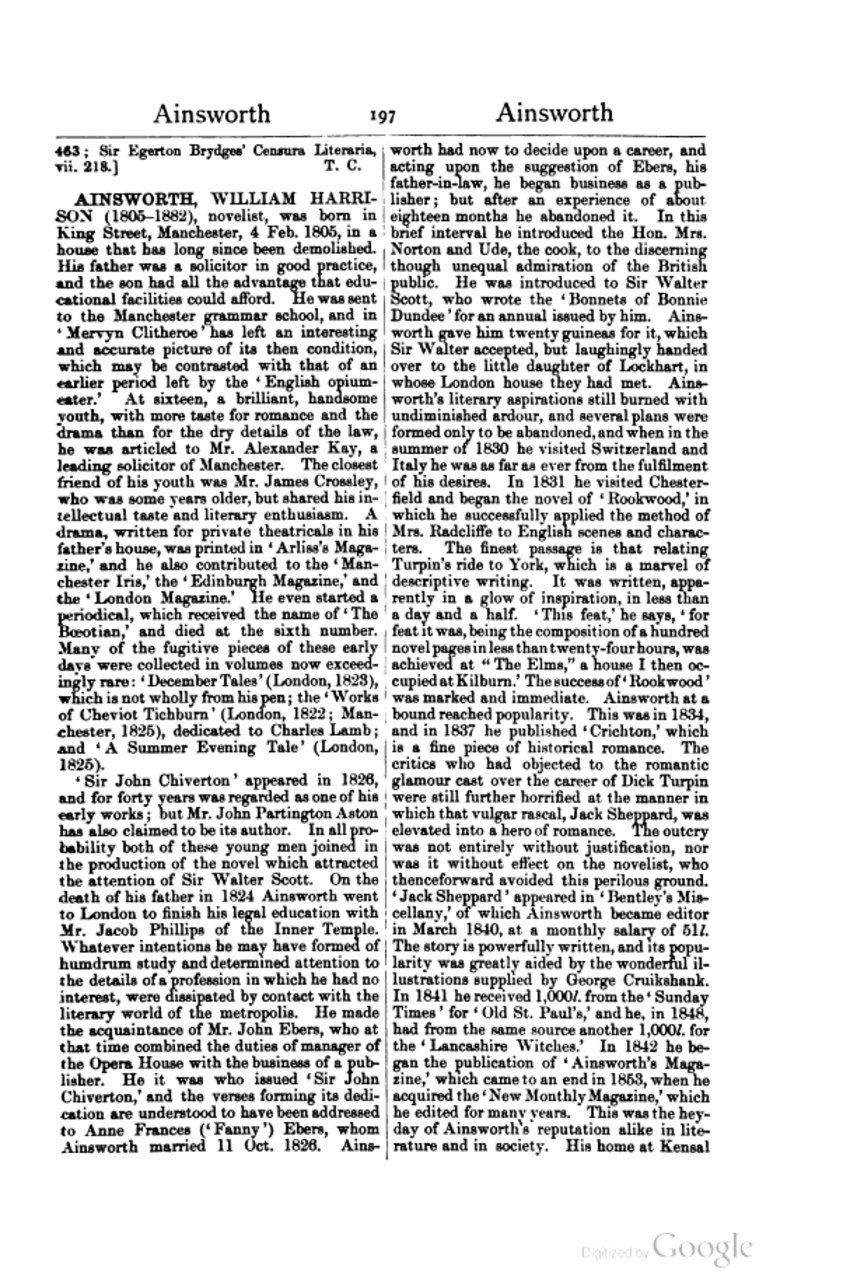AINSWORTH, WILLIAM HARRISON (1805–1882), novelist, was born in King Street, Manchester, 4 Feb. 1805, in a house that has long since been demolished. His father was a solicitor in good practice, and the son had all the advantage that educational facilities could afford. He was sent to the Manchester grammar school, and in ‘Mervyn Clitheroe’ has left an interesting and accurate picture of its then condition, which may be contrasted with that of an earlier period left by the ‘English opium-eater.’ At sixteen, a brilliant, handsome youth, with more taste for romance and the drama than for the dry details of the law, he was articled to Mr. Alexander Kay, a leading solicitor of Manchester. The closest friend of his youth was Mr. James Crossley, who was some years older, but shared his intellectual taste and literary enthusiasm. A drama, written for private theatricals in his father's house, was printed in ‘Arliss's Magazine,’ and he also contributed to the ‘Manchester Iris,’ the ‘Edinburgh Magazine,’ and the ‘London Magazine.’ He even started a periodical, which received the name of ‘The Bœotian,’ and died at the sixth number. Many of the fugitive pieces of these early days were collected in volumes now exceedingly rare: ‘December Tales’ (London, 1823), which is not wholly from his pen; the ‘Works of Cheviot Tichburn’ (London, 1822; Manchester, 1825), dedicated to Charles Lamb; and ‘A Summer Evening Tale’ (London, 1825).
‘Sir John Chiverton’ appeared in 1826, and for forty years was regarded as one of his early works; but Mr. John Partington Aston has also claimed to be its author. In all probability both of these young men joined in the production of the novel which attracted the attention of Sir Walter Scott. On the death of his father in 1824 Ainsworth went to London to finish his legal education with Mr. Jacob Phillips of the Inner Temple. Whatever intentions he may have formed of humdrum study and determined attention to the details of a profession in which he had no interest, were dissipated by contact with the literary world of the metropolis. He made the acquaintance of Mr. John Ebers, who at that time combined the duties of manager of the Opera House with the business of a publisher. He it was who issued ‘Sir John Chiverton,’ and the verses forming its dedication are understood to have been addressed to Anne Frances (‘Fanny’) Ebers, whom Ainsworth married 11 Oct. 1826. Ainsworth had now to decide upon a career, and acting upon the suggestion of Ebers, his father-in-law, he began business as a publisher; but after an experience of about eighteen months he abandoned it. In this brief interval he introduced the Hon. Mrs. Norton and Ude, the cook, to the discerning though unequal admiration of the British public. He was introduced to Sir Walter Scott, who wrote the ‘Bonnets of Bonnie Dundee’ for an annual issued by him. Ainsworth gave him twenty guineas for it, which Sir Walter accepted, but laughingly handed over to the little daughter of Lockhart, in whose London house they had met. Ainsworth's literary aspirations still burned with undiminished ardour, and several plans were formed only to be abandoned, and when in the summer of 1830 he visited Switzerland and Italy he was as far as ever from the fulfilment of his desires. In 1831 he visited Chesterfield and began the novel of ‘Rookwood,’ in which he successfully applied the method of Mrs. Radcliffe to English scenes and characters. The finest passage is that relating Turpin's ride to York, which is a marvel of descriptive writing. It was written, apparently in a glow of inspiration, in less than a day and a half. ‘This feat,’ he says, ‘for feat it was, being the composition of a hundred novel pages in less than twenty-four hours, was achieved at “The Elms,” a house I then occupied at Kilburn.’ The success of ‘Rookwood’ was marked and immediate. Ainsworth at a bound reached popularity. This was in 1834, and in 1837 he published ‘Crichton,’ which is a fine piece of historical romance. The critics who had objected to the romantic glamour cast over the career of Dick Turpin were still further horrified at the manner in which that vulgar rascal, Jack Sheppard, was elevated into a hero of romance. The outcry was not entirely without justification, nor was it without effect on the novelist, who thenceforward avoided this perilous ground. ‘Jack Sheppard’ appeared in ‘Bentley's Miscellany,’ of which Ainsworth became editor in March 1840, at a monthly salary of 51l. The story is powerfully written, and its popularity was greatly aided by the wonderful illustrations supplied by George Cruikshank. In 1841 he received 1,000l. from the ‘Sunday Times’ for ‘Old St. Paul's’ and he, in 1848, had from the same source another 1,000l. for the ‘Lancashire Witches.’ In 1842 he began the publication of ‘Ainsworth's Magazine,’ which came to an end in 1853, when he acquired the ‘New Monthly Magazine,’ which he edited for many years. This was the heyday of Ainsworth's reputation alike in literature and in society. His home at Kensal
